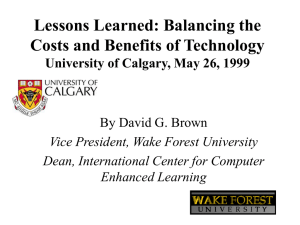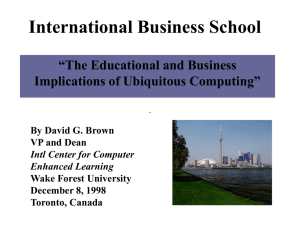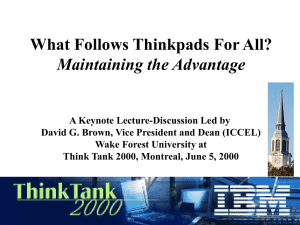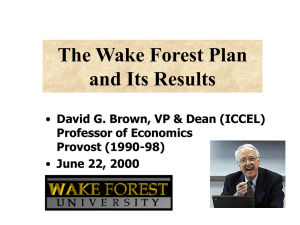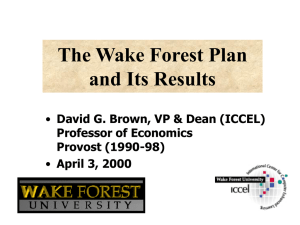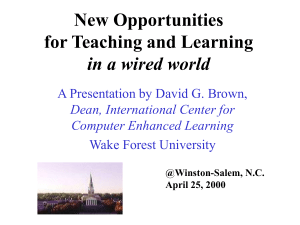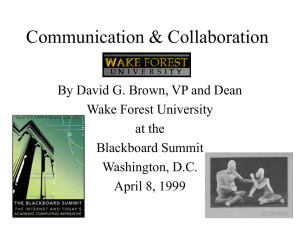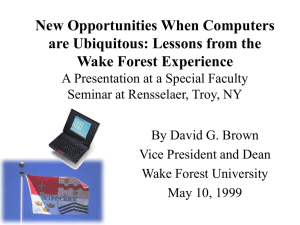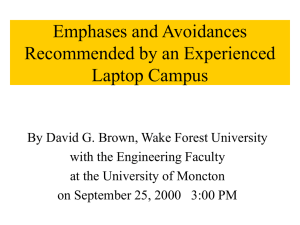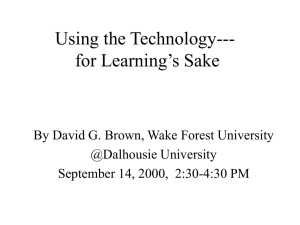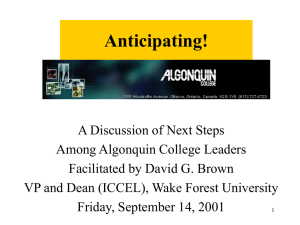New Opportunities for Tomorrow’s Colleges in a world of e-businesses
advertisement
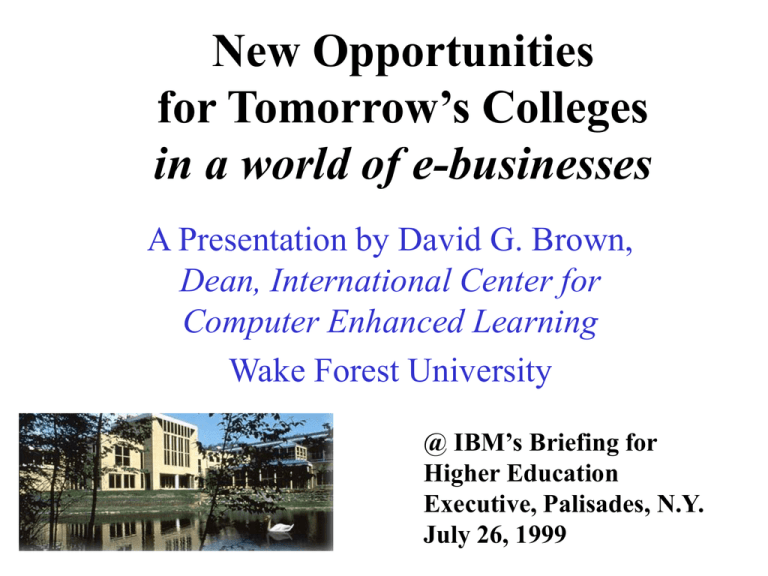
New Opportunities for Tomorrow’s Colleges in a world of e-businesses A Presentation by David G. Brown, Dean, International Center for Computer Enhanced Learning Wake Forest University @ IBM’s Briefing for Higher Education Executive, Palisades, N.Y. July 26, 1999 New Day! Our Heyday! New Day: Times of Rapid Change • • • • • • Universal Access to the Network From Access to Filtering a Flood of Info Geographic barriers gone Asynchronous Interaction Multimedia Learners Information Filtering Agents New Day Big Changes for Higher Education Democratization of Access (Ubiquity) Democratization of Usage (Course Shells) New Day! Our Heyday! Why Heyday? Heyday Because--Universities Survive Change • • • • • • 67 of the 74 oldest organizations! Distribute authority Tolerate Kooks House young people with fresh ideas House bright people with diverse views Employ knowledge fountains What does our own training and experience teach us about doing e-business in a world newly enriched by information? Economist-Princeton UNC CH Provost and President--Drake, Miami of Ohio, Transylvania, UNCA, Wake Forest Dean ICCEL Wake Forest 1998- 1958-67 1967-1998 YOUR TASK: Make Your Own Chart, Then List 3 Ideas about EBusiness in Universities that emerge from your training/experience! The economist in me says that doing business in an info-rich society will be different • • • • • • • • Better informed buyers (web browsing) Better informed sellers (metadata) More data-based decisions Faster cycle times Less geographic loyalty More interactive transactions More customization More specialization (& outsourcing) THE WAKE FOREST PLAN F96: IBM 365XD, 16RAM, 100Mhz, 810MB, CD-ROM, 14.4 modem F97: IBM 380D, 32 RAM, 130Mhz, 1.35GB, CD-ROM, 33.6 modem F98: IBM 380XD, 64 RAM, 233 Mhz, 4.1GB, CD-ROM, 56 modem F99: IBM 390, 128RAM, 333 Mhz, 6 GB, CD-ROM, 56 modem • • • • • • Thinkpads for all New Every 2 Years Own @ Graduation Standard Template IGN for Faculty Keep Old Computers • 75% CEI Users • +15% Tuition • 4 Year Phase In 1999 Software Load Netscape 4.5, Dreamweaver 2, SPSS 9, Maple V 5.1 Windows 98, MS Office Prof 97 Computers Enhance My Teaching and/or Learning Via-Presentations Better--20% More Opportunities to Practice & Analyze--35% More Access to Source Materials via Internet--43% More Communication with Faculty Colleagues, Classmates, and Between Faculty and Students--87% Computers allow people---• to belong to more communities • to be more actively engaged in each community • with more people • over more miles • for more months and years • TO BE MORE COLLABORATIVE ICCEL -- Wake Forest University, 1999 With Ubiquity--The Culture Changes • Mentality shifts-- like from public phone to personal phone. • Teaching Assumptions shift-- like from readings are on reserve to everyone owns a copy of his/her own. • Timelines shift-- like from “our class meets MWF” to “we see each other all the time and MWF we meet together” • Students’ sense of access shifts-- like from “I can get that book in the library” to “I have that book in my library.” • Relationships shift-- like from a family living in many different states to all family members living in the same town Examples from My Own Class •1247 e-mails •Cybershow •One Minute Paper •Computer Tip Talk •Joint Editing Beliefs of 91/93 Vignette Authors Pedagogy and Philosophy • • • • • • • From Interactive Learning Forthcoming June, 1999 From Anker Publishing David G. Brown, Editor Interactive Learning Learn by Doing Collaborative Learning Integration of Theory and Practice Communication Visualization Different Strokes for Different Folks ICCEL -- Wake Forest University, 1999 The educator in me says that doing business in an info-rich society will be different • More Communication • More Community Loyalty • More Collaboration • More Customization • More Interactivity New Opportunities for Tomorrow’s Colleges in a world of e-businesses The New Business Environment • Many Tightknit Communities. Customer Affinity and Bargaining Groups • Interactivity Expected. Between customer and vendor and among vendors’ customers • Information Filters Everywhere. Challenge is gaining and maintaining customer attention • Worldwide Specialization. Geography less relevant. What Business Am I In? Primary: Linking trusting clients with the best educational resources and motivating them to use them. Consolidator! Secondary: Creating educational resources for other “consolidators” to buy Tertiary: Selling auxiliary services such as meals, overnights, t-shirts, mailing lists Your Task: Are these your businesses? If not, what are? Therefore, I should--• Focus on my comparative advantages • Strengthen ties with my natural constituencies • Partner with organizations that can provide outsourcers who understand my infrastructure • Build a reliable infrastructure • Enable my “team” to be interactive 7x24 Your Task: You get to sit out this one! • Specific Actions to be Taken-Empower employees with - equipment, • • • • • • • training, and support (democratize) Partner with “IBM” Adopt “infrastructure” usable by my clients Use fast-loading webpages that fit all screens KISS (both producer and client) Collect and use Metadata Test how easily search engines find you Trade referrals with other sites YOUR TASK: Extend this List! More Specific Actions-• • • • • • • Create & Join Community Networks Act on the 80/20 and 20/80 assumption Customize service to natural constituency Nurture My Clusters of Learners Offer e-mail forwarding for life Use headliners to attract loyalty to site Build monitored LISTSERVS-- especially before enrollment and after graduation • Presume that all information will be shared Basic Themes • • • • • • • Heyday Communication Customization Collaboration Community Interactivity Know What Business You’re in David G. Brown Wake Forest University Winston-Salem, N.C. 27109 336-758-4878 email: brown@wfu.edu http//:www.wfu.edu/~brown fax: 336-758-4875
